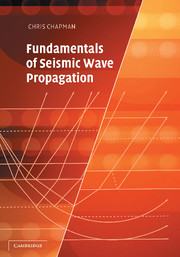Book contents
- Frontmatter
- Contents
- Preface
- Preliminaries
- 1 Introduction
- 2 Basic wave propagation
- 3 Transforms
- 4 Review of continuum mechanics and elastic waves
- 5 Asymptotic ray theory
- 6 Rays at an interface
- 7 Differential systems for stratified media
- 8 Inverse transforms for stratified media
- 9 Canonical signals
- 10 Generalizations of ray theory
- Appendices
- Bibliography
- Author index
- Subject index
8 - Inverse transforms for stratified media
Published online by Cambridge University Press: 19 January 2010
- Frontmatter
- Contents
- Preface
- Preliminaries
- 1 Introduction
- 2 Basic wave propagation
- 3 Transforms
- 4 Review of continuum mechanics and elastic waves
- 5 Asymptotic ray theory
- 6 Rays at an interface
- 7 Differential systems for stratified media
- 8 Inverse transforms for stratified media
- 9 Canonical signals
- 10 Generalizations of ray theory
- Appendices
- Bibliography
- Author index
- Subject index
Summary
Having obtained the transformed response of a stratified medium, i.e. in the spectral (frequency), plane-wave (wavenumber) domain, it is necessary to invert the transforms, to obtain the impulsive, point-source response. An elegant, exact technique, the Cagniard-de Hoop-Pekeris method, which can be used in models with homogeneous layers, or with the WKBJ iterative solution in stratified layers, and an approximate method, the WKBJ seismogram method, are developed in this chapter. For realistic models, these methods are often impractical and numerical methods are necessary. We describe the techniques necessary for the numerical, spectral method.
In this chapter, we investigate different methods of obtaining the Green function from the transformed response. The first problem of this type solved in seismology is now know as Lamb's problem after the classic paper by Lamb (1904). Lamb investigated the excitation of seismic waves in a homogenous half-space due to a point force source on the surface. He used what we would call asymptotic methods in the spectral domain (see Section 8.5), and explained the excitation of head and Rayleigh waves. As the same mathematical techniques can be used whether the source is on the surface or buried, we now refer to the problem of exciting waves in a homogeneous half-space due to any source as Lamb's problem. The problem was investigated in much greater detail by Lapwood (1949) and Garvin (1956), but it was not until the papers of Pekeris (1955a, b) that complete, exact solutions were obtained.
- Type
- Chapter
- Information
- Fundamentals of Seismic Wave Propagation , pp. 310 - 377Publisher: Cambridge University PressPrint publication year: 2004



